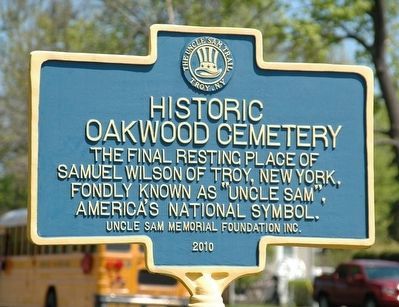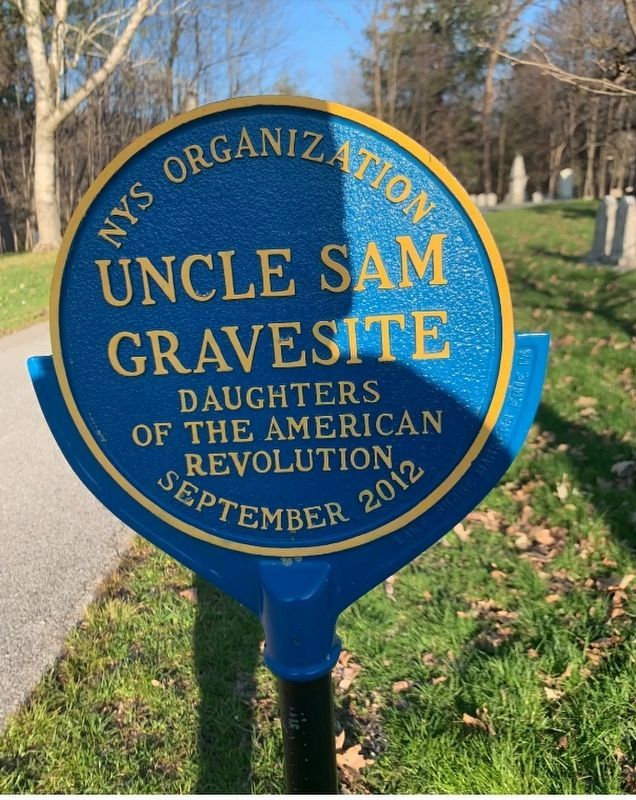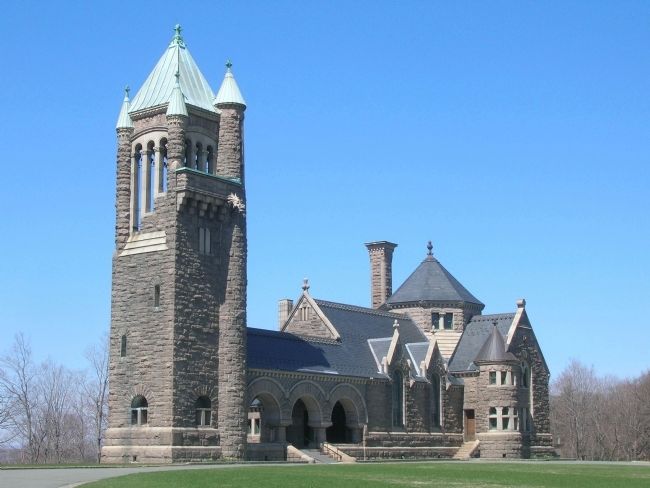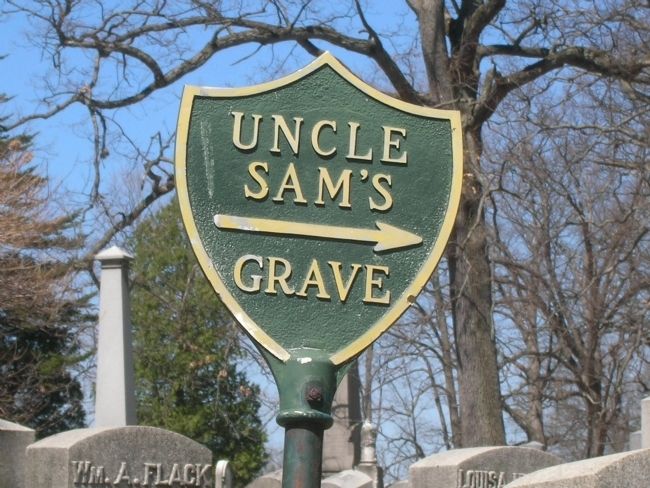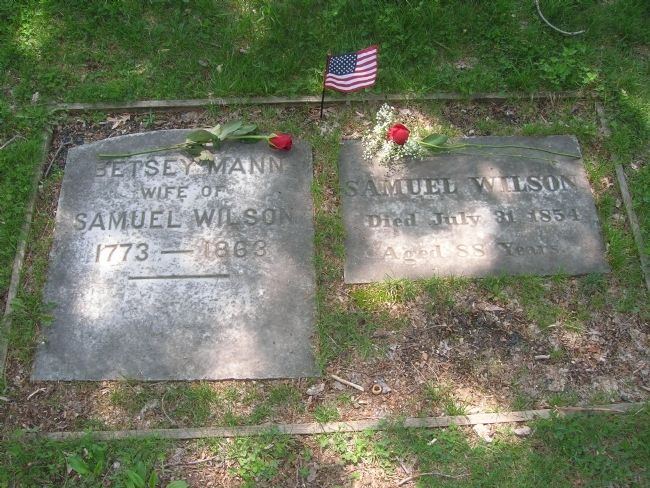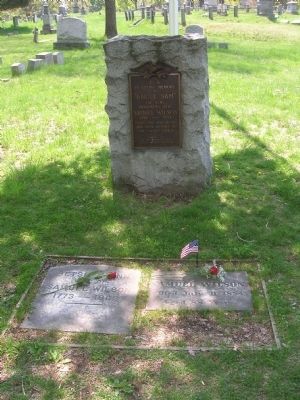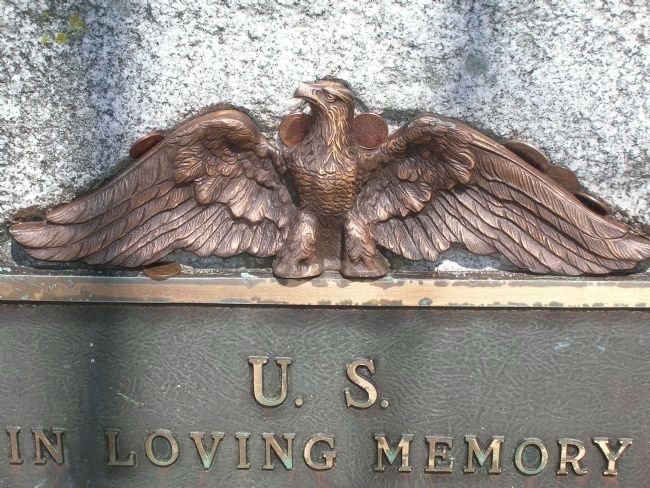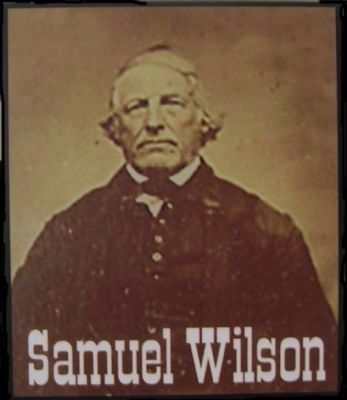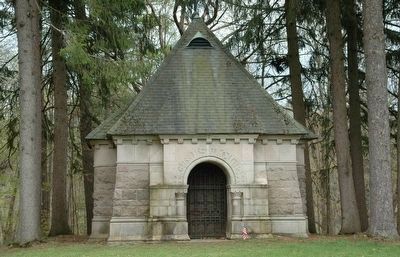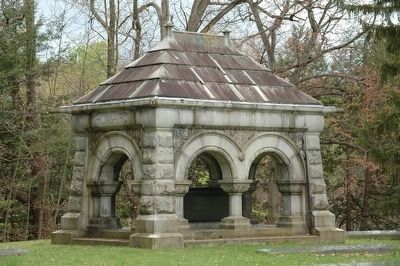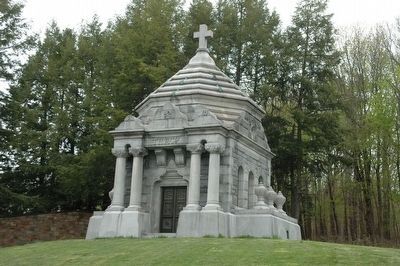Troy in Rensselaer County, New York — The American Northeast (Mid-Atlantic)
Historic Oakwood Cemetery
Troy, NY
Historic
Oakwood Cemetery
The Final Resting Place Of
Samuel Wilson of Troy, New York,
Fondly Known As "Uncle Sam",
America's National Symbol.
Erected 2010 by Uncle Sam Memorial Foundation Inc.
Topics. This historical marker is listed in these topic lists: Cemeteries & Burial Sites • Patriots & Patriotism • Settlements & Settlers • War of 1812. A significant historical year for this entry is 2010.
Location. 42° 45.187′ N, 73° 40.232′ W. Marker is in Troy, New York, in Rensselaer County. Marker is on Oakwood Ave. (New York State Route 40), on the right when traveling south. The marker is located at the entrance to Oakwood Cemetery. Touch for map. Marker is in this post office area: Troy NY 12182, United States of America. Touch for directions.
Other nearby markers. At least 8 other markers are within walking distance of this marker. Gardner Earl Memorial Chapel & Crematorium (approx. 0.2 miles away); William Henry Freeman (approx. 0.2 miles away); Third Street Burial Grounds, 1824 (approx. ľ mile away); St. Peter's Cemetery (approx. 0.3 miles away); George Henry Thomas (approx. 0.3 miles away); Oakwood Cemetery (approx. 0.4 miles away); John Paine (approx. 0.4 miles away); Warren Family Mortuary Chapel: 1861 (approx. 0.4 miles away). Touch for a list and map of all markers in Troy.
Regarding Historic Oakwood Cemetery.
Will the Real Uncle Sam Stand Up!
by Don Rittner
It seems some writers are all fired up that Troy, NY claims to be the home of “Uncle Sam” via the life of Samuel Wilson who lived in Troy from the late 1700's to 1854. These writers point to this publication or that publication to try and prove that the term Uncle Sam was used to denote the United States before Samuel Wilsonís connection. Letís examine the issue and try to put this to rest.
Samuel and his brother Ebeneezer Wilson walked from Mason, New Hampshire to Troy in 1789 and it is written set up a brick making business near the west side of Mt. Ida near Sixth Avenue and Ferry Street. It has been written that they supplied bricks for the first brick house to be built in the village on Second and Albany (Broadway) Streets and the two story building was built for James Spencer. They made bricks also for the first court house and jail.
We do know that the Wilson
brothers were involved in politics early on because on March 20, 1804 they were elected to a committee to elect Republican candidates. We know that Sam was involved in politics most of his life either serving on committees or being appointed to the position of inspectors of beef and pork in Rensselaer County and its towns by various governors. For example, on March 17, 1815 he was appointed inspector of beef and pork for Hoosick while Ebeneezer was appointed Justice of the Peace in Troy. On March 12, 1822 Sam was appointed inspector of beef and pork for the county of Rensselaer by Gov. De Witt Clinton. On Mach 18, 1828 he was elected inspector of beef and pork in Rensselaer County with three others. The following year on July 14, 1829 he was president of political committee dinner in Mechanic Hall and the following year 1830 the governor appointed him inspector or beef and pork for Rensselaer County. On Nov 10, 1835, Sam was president of a vigilance committee for the first four wards of the city. On November 10, 1837 he was elected president of a committee supporting Van Buren for Governor. On August 7, 1840, Samuel Wilson was nominated as president of the Democratic Committee at Military Hall, Rally of the Democracy of Troy, supporting Martin Van Buren. On August 11, 1840 he changed his mind apparently and wrote a letter to the editor of a newspaper stating he is dropping from the Whig party which supported Harrison but seems to have changed his preference back for Van Buren.
Sam Wilson was also known to own real estate around the state. He purchased and sold real estate in the Catskills with his younger brother Nathaniel and lived in Catskill for five years between 1817-1822. Ironically, Sam and Nathaniel lived in a house on Main Street that was the same house that Martin Van Buren married his bride in 1807. He came back to Troy later in 1822. Nathaniel stayed in Catskills and died there in 1854.
So it is clear that before and after Samuel Wilson was attributed as the Government icon of “Uncle Sam” he was a well known entity around New York State and beyond from his land holdings and political connections.
The Wilsonís also were in the meat slaughtering business and general provisions which bought and sold produce and products from around the northeast. It is known that in the earlier days of Lansingburgh to the north the Northern Turnpike connected our region with the Vermont economic communities and provided a good back and forth flow of goods. Ebeneezer and Sam along with one of his in-laws James Mann (Sam married Betsy Mann) opened a dry goods crockery and grocery stores known as Wilson, Mann & Co near the upper Ferry and opposite Ashleyís old Stand (Ferry and River) in 1810. Sam also ran a store at Spring
and Hill Streets near the Poestenkill. We know this business and the meat slaughtering business was in operation in 1810. Wilsonís notoriety in politics, business, land holdings, and the slaughter house would have been known to Vermonters, those in neighboring Massachusetts, and elsewhere where the communities were connected by turnpike or rivers. Samuel Wilson had three homes in Troy, the first was at the site of the Plum Memorial Building on Ferry and Second. The second was destroyed to make room for the Russel Sage College Administration Building and the third was at 144 Ferry Street torn down during the countryís Bicentennial Celebration in 1976. There was an attempt in the 1950s to get Congress to declare it a national monument but it failed.
What other writers have been lacking is the knowledge that if you grow up in Troy you know calling someone uncle of aunt was a very common way to acknowledge a friend of your parents or endearment to someone you knew. I had an Aunt Maybell and Aunt Stacia on Eight Street and 3rd Street. They werenít really related to me but that is what I called them as a term of endearment and respect and I would bet money that any Trojan older than 50 will tell a similar story.
So we know that Sam Wilson, or “Uncle Sam” as he would be called by locals who knew him and liked him was a well known politician and businessman
in Troy BEFORE the War of 1812 and his reputation would have extended outside the immediate area and into regions of the Northeast in which he probably had business dealings.
His associations with the government then, well known already, was increased when he won the contract to supply meat for the War of 1812 to the troops that were stationed nearby in Greenbush. The soldierís called it “Uncle Samís Beef.” Itís been written that a contractor for the army in the New Orleans district wrote asking for a supply of beef and insisted it had to be the “Uncle Sam brand.” It is here where the story was told about the connection. And the newspaper connects Uncle Sam to Sam Wilson as early as 1813.
Now some deriders claim that there were other suggestions as to the use of U.S. – Uncle Sam and not with Sam Wilson. However these references are all after the 1812 connection to Sam Wilson.
The Troy Post wrote in its September 7, 1813 edition:
“Loss upon loss, and no ill luck stirring [sic] but what lights upon Uncle Samís shoulderís, exclaim the Government editorsÖ.This name for our Government has got almost as current as “John Bull.” The letters U.S. on the Government waggons, & C., are supposed to have given rise to it.”
Key phrase here is “waggons & C., “which mean other things too
like perhaps barrels of meat, and of course the barrels were all moved in wagons? So is the comment referring to U.S. on the wagons or the barrels in the wagons or both? We already know that the U.S. on barrels was attributed to Wilson. So this statement does not disprove the Wilson connection at all but being written in Troy where the term originated makes perfect sense in print. It is important to point out the majority of the printed accounts of Uncle Sam and Samuel Wilson were all local and regional Northeast newspapers.
The February 3, 1814 edition of the Commercial Advertiser states:
“Herkimer Jan 27. “Uncle Samís hard bargains – on Thursday afternoon of last week, about thirty sleighs, “more or less” loaded with the “weak and wounded, sick and sore” of our armies on the frontiers, passed through this village for Greenbush.”
Since Sam Wilson was connected to the barracks at Greenbush as the meat supplier this entry does not dispute the Wilson connection at all.
The Aug 12, 1816 New York Courier wrote:
“Uncle Samís Pedigree.
Uncle Sam is a cant phrase, significant of the United States; as John Bull signifies England. The origin of it seems [my emphasis] to be this. In the year 1807, there was authorized by law, the raising of a regiment of Light Dragoons. That initial letters USLD were painted on their caps, meaning the United States Light Dragoons. A countryman seeing a regiment of them passing by, inquired of a bye stander what they were and received for answer “They are Uncle Samís Lazy Dogís donít you see it on their caps!” This story soon got amongst the soldiers and they have ever since denominated the United States “Uncle Sam.”
Problem with this entry is twofold. First it says the origin seems to be this? And it also does not say when the so called by stander gave the answer? Did he see the regiment passing by in 1807 or 1816? Probably the latter and Sam Wilson was already established as Uncle Sam so the USLD falls right in line with what the troops were already associating U.S. with Sam Wilson.
On Aug 14, 1817, The Northern Post citing the local Albany Gazette wrote:
“Uncle Sam”
This expression, which originated, during the war, from the initials US on the soldierís knapsacks, has come into general use. The Indians at the west, from hearing it often used have imbibed the idea that it is actually the name of the president; and while at Sacketts Harbor, a considerable number of Indians and squaws, crowded round the president, wishing as they expressed it, “to shake hands with Uncle Sam.”
Again, they state that the expression came into use during
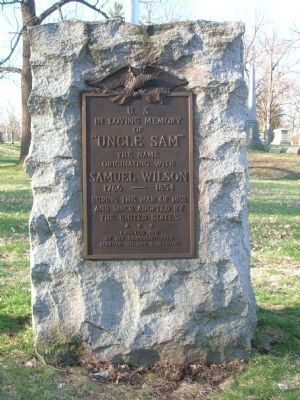
Photographed By Howard C. Ohlhous, April 17, 2008
8. Uncle Sam Graveside Memorial
This memorial has nearly identical plaques on opposite sides of the granite block. The plaque on the side that faces the Wilson grave has parenthesis around the last word on the marker, "(Sheldon)", however the other side which faces the nearby flagpole does not have parenthesis, "Sheldon". Compare this photo with photo #8.
The Troy Daily Times published this Obit under July 1, 1854:
“Died – Samuel Wilson, aged 88 years, died this morning at his residence, 76 Ferry Street. The deceased was one of the oldest inhabitants of this city. He came to Troy about the year 1793, and consequently had resided here sixty-one years. He was the last of those termed “First settlers.” Mr. W. purchased the lands east of this city, now owned by Messrs. Vail and Warren, and occupied by them for farming purposes till about 1820. He then sold them all, except four acres, upon which his present residence stands. He has been one of the most active business men of the community, and we can truly say he was an honest and upright man.”
When Wilson died in 1854 at his home at 144 Ferry Street the Albany Evening Journal paper published this Obit on Aug 2:
“Uncle Sam
The death of Samuel Wilson, an age, worthy and formerly enterprising citizen of troy, will remind those who were familiar with incidents of the War of 1812, of the origin of the popular soubriquet for the ”United States.”
Mr. Wilson, who was
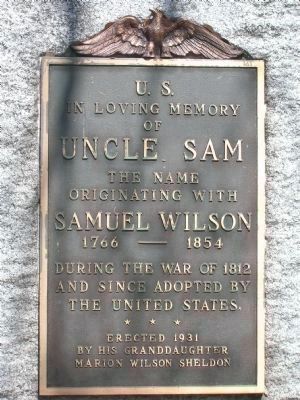
Photographed By Howard C. Ohlhous, April 17, 2008
9. Uncle Sam Graveside Memorial
Beside the grave stands a monument to Sam Wilson:
U.S.
In Loving Memory
of
"Uncle Sam"
The Name
Originating With
Samuel Wilson
1766 --- 1854
During the War of 1812
and Since Adopted by
The United States.
* * *
Erected 1931
By His Granddaughter
Marion Wilson Sheldon.
In Loving Memory
of
"Uncle Sam"
The Name
Originating With
Samuel Wilson
1766 --- 1854
During the War of 1812
and Since Adopted by
The United States.
* * *
Erected 1931
By His Granddaughter
Marion Wilson Sheldon.
What is important in this obit is the phrase, “he was everywhere known and spoke of as Uncle Sam.” This obit was picked up by many newspapers and republished. No one ever wrote a rebuttal to it.
One writer remarked that why did the Troy Post obit not mention the Uncle Sam connection? Pretty easy. Between 1812 and 1854 there were 35 newspapers published in Troy. Do you really think every obit writer knew the complete history of everyone who died there? The fact that the Albany editor knew it just proves the point.
The New York Herald Tribune on June 12, 1889 quoting the Chicago News wrote:
“How “Uncle Samí Got his Name
The term came into use in the War of 1812, and originated in Troy, N.Y. The Government inspector there was Samuel Wilson, universally known
as Uncle Sam. Whenever he inspected supplies furnished the Government he would brand them U.S., meaning United States, but the abbreviation, being then new and not generally recognized, the workmen supposed it to mean Uncle Sam, the inspector. Afterward, the story was repeated and got into print, and from that time the name has been facetiously applied to the United States.”
The Red Hook Journal on January 13, 1892 published this:
“At the beginning of this century the slaughtering of cattle and packing of beef for New York, Boston, and Philadelphia markets was pursued as a business by the first of Ebeneezer and Samuel Wilson, two brothers from Mason, N.H., who had settled at Troy in 1789. At their two large slaughter houses they frequently killed 1,000 head of cattle weekly for shipment to those cities. When the war of 1812-15 began their beef and pork were in great demand and not a few army contractors gave them large orders for the delivery of these meats packed in barrels at a certain places where the army was encamped. From time to time their contracts stipulated for the delivery of these provisions at the camp at Greenbush, where, among other recruits, were a number from Troy.
The soldiers from Troy, seeing the barrels of beef and port marked with the letters “U.S.” by the government inspectors, denominated them as “Uncle
Sam”meaning that Samuel Wilson, whom they familiarly called :Uncle Sam” was the person from whom the meat was purchased. The other soldiers assuming that the term “Uncle Sam was applied to the letters U.S. Stamped on the barrels, began using the appellation “Uncle Sam” figuratively for the United States Government. From that time the designation “Uncle Sam: for the letters “U.S.: grew into popular acceptance and has ever since been as familiarly known as that of “John Bull” for the English nation.”
The Northern Christian Advocate in 1896 published the following:
“How “Uncle Samí Got his Name
The nickname “Uncle Sam, as applied to the United States government, is said to have originated as follows: Samuel Wilson, commonly called “Uncle Sam” was as a government inspector of beef and pork at Troy, NY about 1812. A contractor, Elbert Anderson, purchased an quantity of provisions, and the barrels were marked “E.A”, Andersonís initials , and U.S.” for United States. The latter initials were not familiar to Wilsonís workmen, who inquired what they meant. A facetious fellow answered, “I donít know, unless they mean “Uncle Sam.” A vast amount of property afterward passed through Wilsonís hands marked in the same manner and he was often
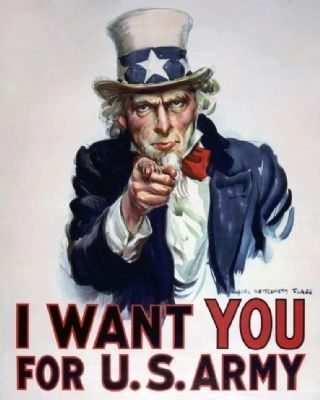
Library of Congress
12. I Want You
As early as the 1830s Uncle Sam became a common cartoon figure, eventually portrayed wearing red, white and blue clothing and sporting gray whiskers. Sam Wilson, however, was always clean-shaven. The most well-known drawing, of a bearded Uncle Sam wearing a star-decorated top hat and pointing an index finger at the viewer, was created by artist James Montgomery Flagg in 1916 and has been used ever since on military recruiting and other posters.
No one wrote a rebuttal to this publication or any of the others that attributed Sam Wilson as Americaís Uncle Sam.
Two year later the New York Herald published this:
“How Uncle Sam was Christened
The origin of the term “Uncle Sam” asked for by H.C.G, is kindly furnished by J.B. Franks. He says: “The term came into use during the War of 1812 and originated at Troy N.Y. The Government inspector there was Samuel Wilson, universally known as “Uncle Sam.” Whenever he inspected supplies furnished the government he would brand them “U.S.” meaning United States, but the abbreviation being then new and not generally recognized, the workmen supposed it to mean” Uncle Sam,” the inspector. Afterward the story was repeated and got into print and from that time the name has been facetiously applied to the United States.”
No one wrote a rebuttal to this story.
Two years later the Irish Work and American industrial Liberator wrote on October 13, 1900 this:
“During the war of 1812 the United States Government employed an inspector by the name of Samuel Wilson. He was familiarly
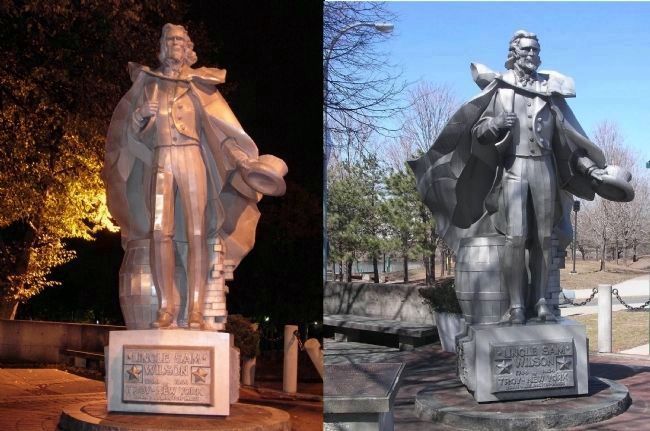
Photographed By Howard C. Ohlhous, October 22, 2008
13. The Uncle Sam Statue in Downtown Troy
The City of Troy, New York embraces its most famous citizen, Uncle Samuel Wilson. A metal sculpture of a male figure representing the natinal symbol, "Uncle Sam" stands atop a sqare aluminum base that rests on a circular brick base. The figure is wearing a long coat billowing in the breeze, top hot in hand and standing before a barrel, the type in which he shipped meat, and a stack of bricks equal in height to the barrel, representing the Wilson brick business. The scuplture is located beside the Uncle Sam Bus Stop at the corner of River Street and Fulton Street in downtown Troy. There are embossed letterings on all four sides of the base of the statue The front side states "Uncle Sam Wilson 1766 1854 of Troy - New York Born in Arlington - Mass" One side states,” Sam Wilson- One of the prime movers For Incorporation of * Troy as Village - 1794 City - 1816 *" On another side the base reads, "Troy's Citizen America's Uncle The Big Thing is Not What Happens to Us in Life - But What We Do About What Happens to Us. Sam Wilson." Another side says, "U.S. of America (written horizontally, and vertically incorporating the letters U.S.,) Uncle Sam Originated During War of 1812" From other plaques placed nearby it would seem the statue was erected through the efforts of the Uncle Sam Monument Committee between December 1977 and September 1980, with a dedication taking place on October 18, 1980.
Only two years later the same paper would write:
“Uncle Sam”
The Wilson homestead, the birthplace of the original “Uncle Sam” was sold at auction April 30 for $1500. The purchase is Capt Orren A Hamblett, of Washington. “Uncle Sam” was Samuel Wilson, born on the farm. During the second war with England he and his brother Edward were contractors for government supplies at Troy, NY. It was the Wilsonís idea to label their beef and pork barrels “U.S.” and as Samuel Wilson was called “Uncle Sam” the army quickly referred to the supplies as “Uncle Samís.” This title quickly was applied to the government and after the war was used everywhere in that sense. Samuel Wilson died in Troy in 1854, age 88 years. The farm was sold because of the death of the last member of the family. It was owned by a Wilson for 122 years.”
One of the best explanations appeared in the journal American Notes and Queries dated June 15, 1889.
“WHENCE THE NAME ”UNCLE SAM”?
This familiar phrase is used as a cant designation of the United States Government, just as John Bull is made to represent the English nation, Johnny Crapaud, the French people, etc. The name is said to have originated in the following manner:
At the time of the War of Independence, there lived at Troy, N. Y., a man named Samuel Wilson, familiarly known to the inhabitants of that vicinity as Uncle Sam, who, together with Ebenezer, his brother, performed the duties of government inspector of the pork and beef purchased by the administration. Among others to purchase provisions for the army, came a certain Elbert Anderson of New York, who, having concluded a large contract, ordered the cases to be marked with his own initials, addressed to the United States.
It was the habit of Uncle Sam Wilson to superintend large shipments in person, and his appearance among the workmen in his employ was always the signal for an interchange of good-natured jocularities. On this occasion it fell to the lot of a facetious young Yankee to do the lettering on the cases containing the provisions; and he accordingly marked them all very carefully in white paint, with the letters “E. A.— U. S.” Being interrogated by some of his fellow-workmen as to the significance of the initials
(for at that time the abbreviation U. S. for United States was still a novelty), he replied that he did not know, unless it meant Elbert Anderson and Uncle Sam, meaning by the latter, his good-natured employer. This pleasantry occurring in the presence of” Uncle Sam” himself, ” took” immediately among the workmen, who, repeating the joke in various forms on every subsequent purchase, were never weary of rallying him upon the rapidly increasing extent of his property.
Many of these same men, being staunch patriots, were shortly afterward numbered among the recruits, and pushed forward to the frontier lines, for the double purpose of meeting the enemy and of helping to devour the provisions they had labored to prepare. They carried with them their old jokes, especially their favorite story of “Uncle Sam” ; and before the first campaign had ended, it made its first appearance in print. Spreading rapidly, and encountering universal recognition as ”a good thing,” the expression took firm root, and will doubtless continue to flourish as long as the government itself.
As the common personification of the U. S. Government, “ Sam” became the popular synonym for the “Know-nothing” or “American” party, the controlling principles of which organization seem to have been a sublime ignorance in all matters concerning the inner workings of their society, combined with a general impression that ” Americans must rule America.”
The adoption of the letters U. S. on the knapsacks of the soldiers, gave rise to the well-known Americanism, ”to standíSam,í” meaning that the government of Uncle Sam must pay, or bear, the expenses of all those who wear his livery; and a song, current at that period, further developed this idea of dignified dependence, in its refrain, “Uncle Sam is rich enough to buy us all a farm.” When Samuel Wilson, the “hero of a hundred “— tales, died at his home in Troy, in August, 1854, at the age of 84, the Albany Argus referred to and recalled the circumstances which had led to the adoption of his name as a sobriquet of the U. S.
In the cartoons of “Uncle Sam,” frequently displayed in current illustrated newspapers, he is depicted as a tall, spare man, with a long, slim, straggling beard on his chin, attired in a dress-coat of blue, bespangled with white stars, and a pair of red and white striped trousers, fastened to his boots with straps; he has long outgrown his clothing, and the straps have stretched half way up his leg; on his head, at an angle perilous to safety, rests a white hat of cylindrical shape, known in vulgar parlance as a” stove-pipe “; a limp and generously expansive collar, confined by a loose redundancy of neckcloth, completes this figure of a typical Yankee.
Although in reality the prop and mainstay of a mighty nation, ”Uncle Sam,” when not engaged in offering some gallant service to the National Goddess, is generally represented as entirely absorbed in whittling a piece of wood. But this assumed indifference is deceptive. Let the British Lion be heard to roar never so timidly on the remotest confines of his territory, and Uncle Sam casts away his jack-knife in a trice, and stands ready to do doughty service for his country and his countryís liberty.”
In 1928 a representative in Indiana introduced a bill to make a Samuel Wilson buried in Merriam, Indiana the man behind the symbol of Uncle Sam. Jay Dunn a Troy Salesman read in a newspaper about the Indiana proposal and wrote to its congressman seeking to stop it. Trojans jumped right into action to disprove this and in 1931 the city of Troy wanted a memorial to him.
Lucius E. Wilson a great grandnephew of Samuel wrote to the city explaining the connection and wrote:
“the landing of a party of visitors here at a wharf where the casks and barrels were assembled for shipment to Greenbush. One of the party asked who owned the provisions. The watchman is said to have replied.
“It is all marked, sir, and it all belongs to Mr. Anderson and Uncle Sam.”
“Uncle Sam? Uncle Sam who?” the inquirer pursued.
“Why Uncle Sam Wilson,” was the reply. “Donít you know? He owns all about here and is feeding the army.”
That same year on May 16, 1931 the Uncle Sam monument and plaque was placed on Wilsonís grave at Oakwood Cemetery. It was secretly paid for and arranged by Mrs. Marion Wilson Sheldon, the granddaughter of Sam Wilson. Later in 1961 she had a statement read by the Mayor at the time:
“As the granddaughter of Samuel Wilson and the last direct descendant bearing his name, I offer you greetings. Although unable to be with you at this time, I greatly rejoice that I have lived to see this glorious day, in which representatives of our grate Nation are gathered here to honor the memory of Samuel Wilson, that dear old man, whose deep love for his fellowmen, together with his upright characteristics won for him the name of :”Uncle Sam” and the distinction of being the typical America. Not only in a humorous way, but also with deep respect does he impersonate our great Republic at home and abroad.
Uncle Sam is known to young and old, to friend and foe, as the straightforward honest character, typifying the vigorous American spirit everywhere. His army guards our homes; his Navy ploughs the seas. In the hearts of the people he ranks above potentates ad Presidents. With his lank body clad in star spangled hat, tight garters and coast as brilliant and brave as the America Flag, his image on the printed page represents at a glance all this is American, depicting Truth and the real America Spirit much better than any written word.
Underneath his rough rock, so typical of his rugged charter, lie the physical remains of Uncle Sam but his all embracing spirit you find wherever the Star Spangle Banner is waving.
Unaware of his contributions to our history and heritage, Samuel Wilson passed away proving the truth of an old saying that: ”A great man is he, who had done no great deed, and ye has become great.”
We, who are Citizens of this Nation and therefore are all Uncle Samís children, should not allow his name to remain unsung. As his granddaughter, I have, in my humble way, endeavored to commemorate his deeds, and to give to the present and the future Citizens of our glorious America an inspiration follow.
And now we leave him to his rest.
The loved ones lying here.
Our Nation wide in cheer”
Thanks, and God bless you all
Signed Mrs., Marion Wilson Sheldon.”
In 1952, Representatives Dean P. Taylor of Troy and Representative Leo W. OíBrien of Albany presented a bill to Congress to acquire 144 Ferry Street and make it a national shrine. It failed. The building was razed during the Bicentennial. But it was thanks to Jessie F. Wheeler in 1961, a retired librarian from the Troy Public Library and Mrs. Elizabeth Allen Thiessen of Troy that we even had knowledge of the Sam Wilson connection. Wheeler spent 40 years collecting material supporting the connection between Wilson of Troy and Uncle Sam. Mrs. Robert Wood Coe, great, great niece of Wilson testified to the Senate Judiciary Subcommittee on Jul 11, 1961 as to the Troy connection of Uncle Sam with Wilson. She retold about her grandmother Harriet Allen Jackson who lived in Massachusetts often spoke about her great uncle. Her uncle William H. Jackson, the famous painter and photographer (who also lived and worked in Troy for a while) painted Uncle Sam but the family never released any of the pictures to the public.
So, to summarize. If it was good enough for the entire 19th century press to give Sam Wilson credit – without anyone contradicting it, Itís good enough for me. Those great words from his own granddaughter acknowledging the Troy connection? Good enough for me! The fact that the U.S. Congress passed a law proclaiming September 13, 1989, “Uncle Sam Day,” (the birthday of Troyís Samuel Wilson) is good enough for me! And finally the Joint Resolution of September 15 1961, that passed recognizing” "Uncle Sam” Wilson, of Troy, New York, as the progenitor of Americaís national symbol of ĎUncle Sam,í is good enough for me!
I would say that there is enough evidence that Troyís Sam Wilson and Americaís Uncle Sam are the same entity.
For those who disagree? Get over it.
(Used with permission)
Also see . . . Gravesite of Uncle Sam - The Official Symbol of The United States.
Uncle Sam is both America's nickname and the official symbol of the United States. His grave site is located in Troy, NY where he lived and died. A historical marker stands next to his gravesite that reads "Uncle Sam Gravesite. The headstone read "Samuel Wilson Dies July 31, 1854 Aged 88 Years Old"(Submitted on May 7, 2023, by HistoricTownsOfAmerica.com - Guy Saladino of Long Beach, New York.)
Credits. This page was last revised on May 10, 2023. It was originally submitted on November 15, 2013, by Howard C. Ohlhous of Duanesburg, New York. This page has been viewed 1,092 times since then and 28 times this year. Photos: 1. submitted on May 15, 2016, by Howard C. Ohlhous of Duanesburg, New York. 2. submitted on May 7, 2023, by HistoricTownsOfAmerica.com - Guy Saladino of Long Beach, New York. 3, 4, 5, 6, 7, 8, 9, 10, 11, 12, 13. submitted on November 15, 2013, by Howard C. Ohlhous of Duanesburg, New York. 14, 15, 16. submitted on May 6, 2016, by Howard C. Ohlhous of Duanesburg, New York. • Bill Pfingsten was the editor who published this page.
